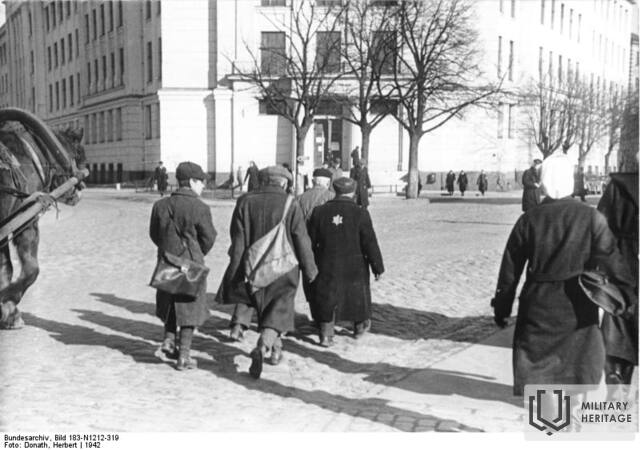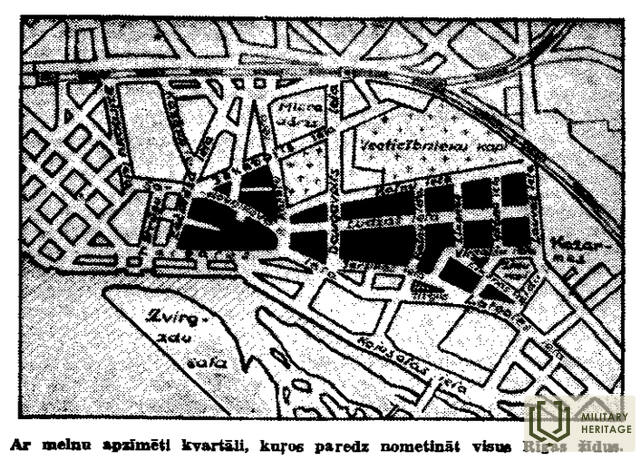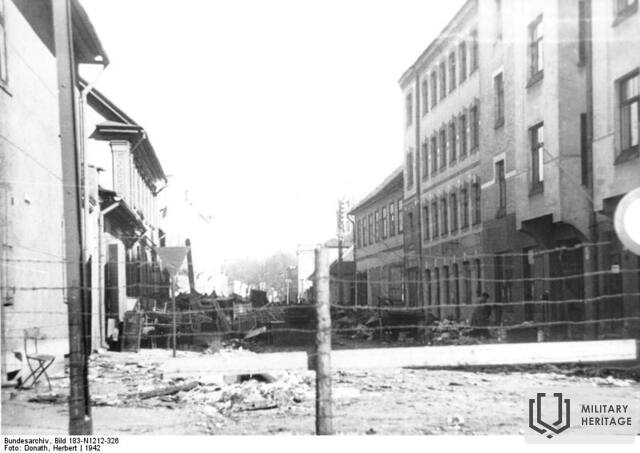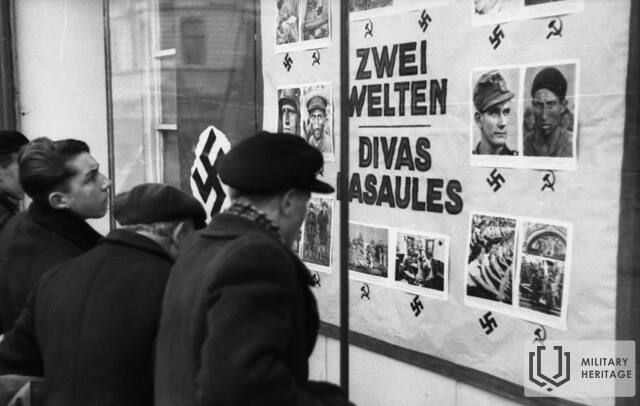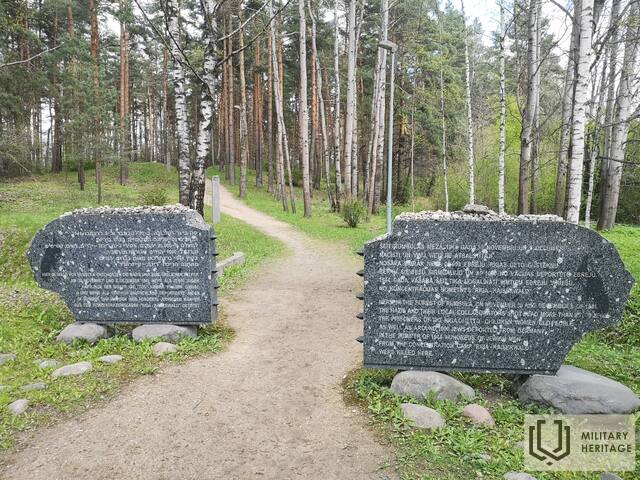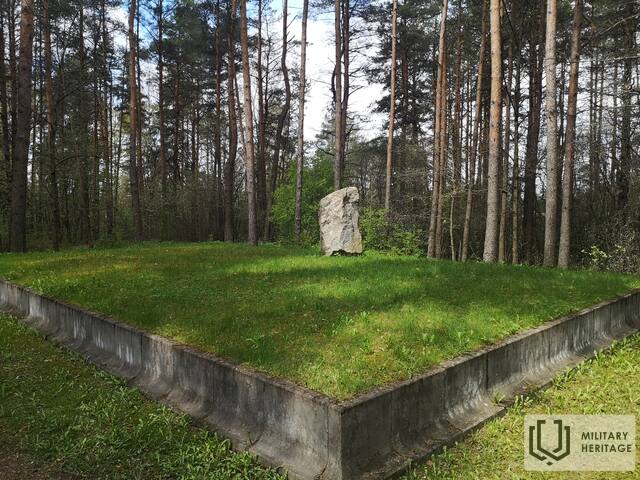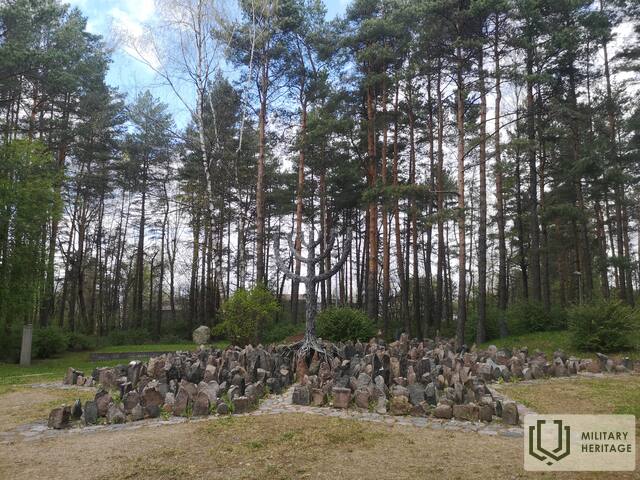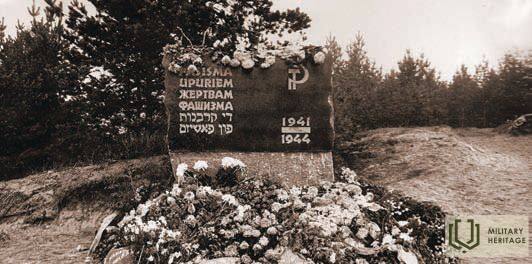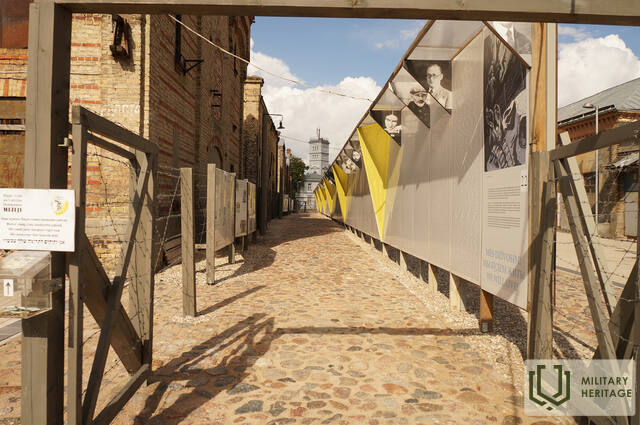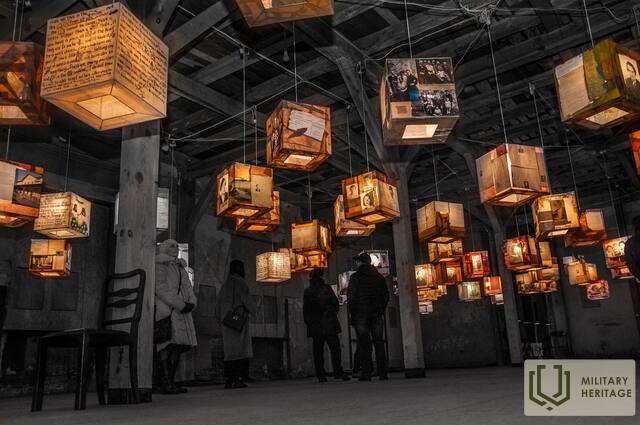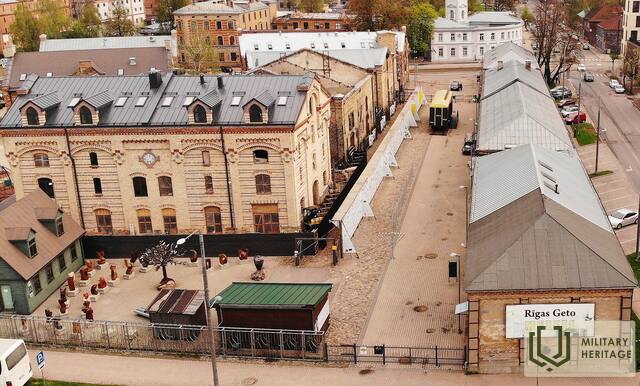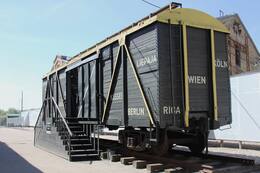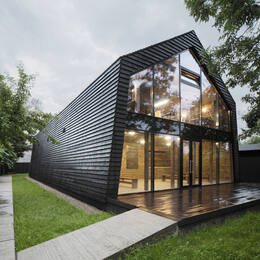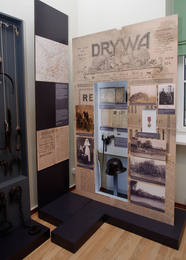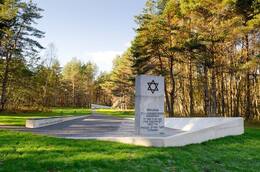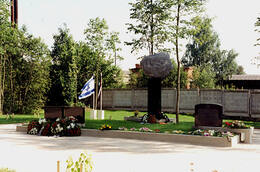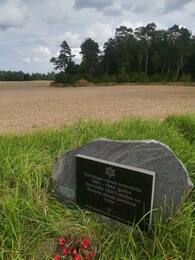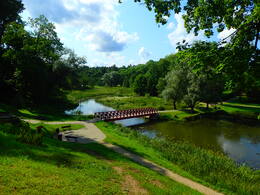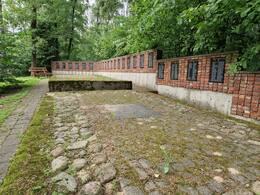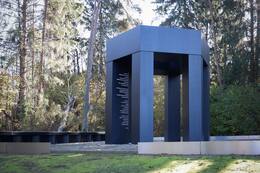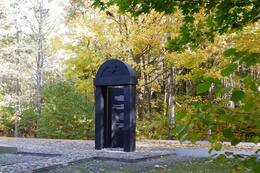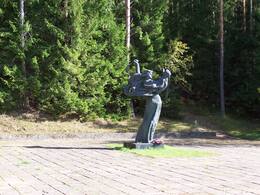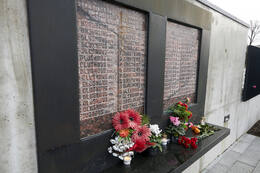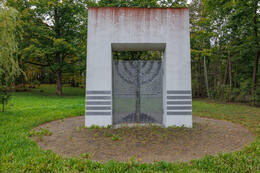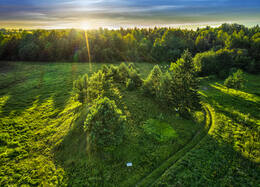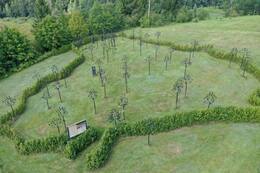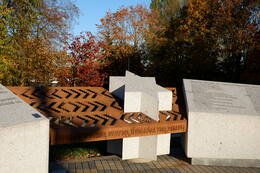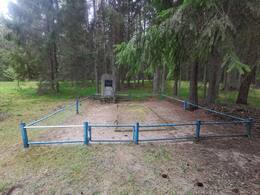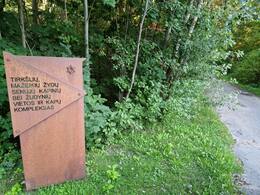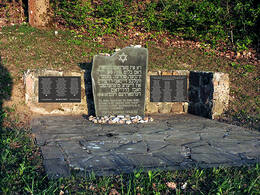Holocaust II World War II
The Holocaust (Greek: holos – all, without a trace; kaustos – burned) – the mass extermination of Jews in Nazi Germany and its occupied territories during World War II. The process of mass extermination of Jews began with the occupation of Poland. With the German invasion of the Soviet Union on June 22, 1941, the active phase of the Holocaust or Shoah (catastrophe) began. The Nazis' secret so-called "Final Solution to the Jewish Question" (Endlösung der Judenfrage) envisaged the killing of all Jews living in the territory of the USSR. In the second half of the 1930s, 93,479 Jews lived in Latvia (1935). Most of the German, Austrian, Hungarian and Czechoslovak Jews deported here during the war were also killed in Latvia. The genocide was also directed against the Latvian Roma and the mentally ill. The Holocaust is the largest mass crime committed against civilians in the history of Latvia – approximately 73,000 Latvian Jews and 16,000 foreign Jews perished during the Nazi occupation.
The Holocaust in German-occupied Latvia was initially carried out by the German security police and SD special unit Einsatzgruppe A – the largest of four such Einsatzgruppes. It was led by SS Brigadier General and Police Major General Walter Stahlecker. Initially, various restrictions and prohibitions were introduced, then Jews were registered, and they were required to sew the symbol of Judaism – the six-pointed Star of David – on their clothing. The Jews had their property confiscated, followed by their isolation and, ultimately, murder. The first murders took place on June 23, 1941, in Grobiņa. The German military and civilian authorities needed to establish their power and involve the local population in the murders. They took place in all settlements where there was even a small number of Jews. The main perpetrators of the murders were specially created SD units under the leadership of Viktors Arajs and Mārtiņš Vagulāns.
Jewish religious buildings – synagogues – were burned down, and on July 4, the Choral Synagogue on Gogoļa Street, built in the second half of the 19th century, was burned down in Riga. On August 23, a ghetto was established in a suburb of Moscow, where 29,602 people were imprisoned. 14,000 were placed in the Daugavpils ghetto, and several thousand in the Liepāja ghetto. On November 30 and December 8, 1941, approximately 25,000 Latvian Jews and 1,000 Jews brought from Germany were killed under his leadership in Rumbula. After the Rumbula massacre, approximately 6,000 Jews who were employed in forced labor survived. In 1944, the survivors were deported to camps in Germany. The German Nazi occupation authorities also committed genocide against the Roma (Gypsy) people of Latvia and the mentally ill. Approximately 2,000 Roma were killed in several Latvian cities, and approximately 2,327 people were killed in psychiatric hospitals in Riga, Daugavpils, Liepaja, Strenči, etc.
More information sources
http://okupacijasmuzejs.lv/lv/aktualitates/4-julijs--ebreju-tautas-genocida-upuru-pieminas-diena-379/
Related objects
Memorial to the victims of holocaust in Liepāja
The largest memorial to Holocaust victims in Latvia is located in Liepāja, in the Šķēde dunes. The memorial is dedicated to the memory of more than 3,000 Liepāja Jews killed during World War II. It is in the form of the Israeli national symbol, a seven-branched candelabra known as the menorah. The contours of the memorial, which are clearly visible from a bird’s eye view, are made of split boulders and granite blocks. The ‘lights’ of the menorah are made of granite pillars with inscriptions of verses from the Lamentations of Jeremiah in Hebrew, English, Latvian and Russian.
Riga Ghetto and Latvian Holocaust Museum
The Riga Ghetto and the Latvian Holocaust Museum is located in Riga close to the Riga Central Market and the Riga Central Station. The museum was opened in 2010 on the site where the city's warehouses once were. It is located in the historical part of the city, next to the border of the former Jewish ghetto. The territory of the ghetto is unique, because in terms of architecture it has not changed since World War II. It is a memorial dedicated to the tragedy suffered by the Jewish people. The German policy regarding the Jewish population in Latvia until the end of 1939 was for the German diplomats and politicians to try and pressure the Latvian government to take action against the Jews by restricting their freedom. After the emigration of the Baltic Germans in 1939, the German embassy no longer had as good an access to information on the mood of the population and the events happening in Latvia as before. When the Red Army occupied Latvia, they manipulated the society to gain some support of the Jewish population for the new occupying power. However, after the regime started a crackdown on the society as a whole, the support fell rapidly. As a result of all this, a deep divide had formed between the people. And later on, the next regime – Germany – tried to exploit it. They hoped that the local population would harass and attack the Jews, but that did not happen. So, Germany adjusted their approach and devised a new plan to initially establish a Jewish ghetto and later destroy its inhabitants.
Varakļāni Jewish Cemetery - a memorial to the victims of German-fascist terror
Varakļāni Jewish Cemetery, at the end of Kapsētas Street.
Two monuments can be seen, which were erected by surviving relatives and friends at the Varakļāni Jewish cemetery after the war.
One of them is located near the cemetery fence, where the mass extermination of Jews took place. The inscription on it in Russian and Yiddish reads: “We will forever mourn our parents, brothers and sisters who died at the hands of the fascists in 1941.” The second monument is located inside the cemetery; at the place where the murdered Jews were later reburied, it also has an inscription in Yiddish and Russian: “Eternal memory to the victims of German-fascist terror – the Jews of Varakļāni, brutally murdered on August 4, 1941.”
Nazi German troops entered Varakļāni in early July 1941 and from the very first days began the restriction of Jews and individual murders. A conditional ghetto was established near the Jewish cemetery, to which all Jews had to move. On August 4, in the territory of the Jewish cemetery, a German SD unit (“Arāja komanda”), with the help of local self-defense forces, shot practically all the Jews of Varakļāni (about 540 people).
Every year on the first Sunday of August, a memorial event dedicated to the Jews killed in Varakļāni is held at the Varakļāni Jewish Cemetery.
Jewish Memorial at Rumbula
Located in Rumbula, near Maskavas Street.
Rumbula is one of the largest sites of mass extermination of Jews in Europe. During two actions – on November 30 and December 8, 1941, which were carried out based on the decision of the Nazi leadership to completely destroy the Jews imprisoned in the Riga ghetto, more than 25,000 people were shot in the Rumbula forest, including approximately 1,000 Jews deported from Germany. In 1944, several hundred Jewish men from the Kaiserwald concentration camp were also killed in Rumbula.
The first attempts to immortalize the memory of the Jews killed in Rumbula date back to the late 1960s. Despite the restrictions of the Soviet government, as a result of the initiative of individual Jews, in 1963 a wooden memorial plaque with an inscription in Yiddish was attached to one of the Rumbula pine trees, while a large poster by artist Josif Kuzkovskis “Jew” was installed near the Rumbula railway (near the Riga-Moscow line). The poster showed an image of a man who seemed to be rising from the grave with a clenched fist, symbolizing a protest against what had been done. Both the memorial plaque and the poster were removed in 1964, but the Jews managed to obtain permission to install a memorial stone in Rumbula with the inscription “To the Victims of Fascism” not only in Latvian and Russian, but also in Yiddish.
On November 29, 2002, a memorial ensemble was opened in Rumbula, designed by architect Sergejs Rižs. Its construction was financially supported by institutions from Latvia, Israel, the USA and Germany, as well as private individuals.
On the side of the highway, by the road leading to the memorial, a metal structure has been installed as a sign, symbolizing the forces of Nazism. Nearby is a stone with an explanation that thousands of Jews were driven to their deaths along this road. At the entrance to the memorial itself, several stone plaques with inscriptions in Latvian, English, German and Hebrew introduce the events of the Rumbula tragedy and the history of the establishment of the memorial. In the central part of the memorial, above the square, which is made in the shape of a Star of David, a seven-branched candelabrum rises – a menorah, around which are placed stones with the names of the Jews killed in Rumbula. The names of the streets of the former Riga ghetto are engraved in individual stones, with which the square is paved. There are several mass graves on the territory of the memorial, the places of which are marked with rectangular concrete borders.
Žanis Lipke Memorial
The Žanis Lipke memorial is located in Ķīpsala, Riga. The Žanis Lipke Museum is probably one of the most hidden museums in Riga. The obscure location of the memorial is not a coincidence and it has a symbolic meaning. It has been set up in the location of a former underground hideout that was created to save people during the German occupation of World War II. Here Žanis Lipke and his family rescued 55 Jews. Nowadays a memorial has been built next to the Žanis Lipke family house. The memorial ‘Black Shed’ is a symbolic building where shelter was provided and received. The design of the building has been taken from the historical tarred huts of Ķīpsala fishermen and sailors. These huts were built using materials from barges; hence they had a very distinct colour and tar smell. But not only the story of this historic place is unique. The way the museum communicates its message is also quite notable. The overall design has similarities with the Noah’s Ark described in the Bible, and it also resembles a boat that has been pulled ashore and overturned – a boat that has fulfilled its task. The concept of this memorial draws from the historic accuracy of this place and story and the testimonies associated with it. It is a story of a desire for freedom, unbelievable escape and trust. On your way to the museum, you’ll also be able to see the historic buildings of Pārdaugava.
Preiļi Museum of History and Applied Arts exhibition "Museum Stories for Latvia"
Located in the premises of the Preiļi Cultural Center.
The Preiļi Museum of History and Applied Arts (PVLMM) exhibition "Museum Stories for Latvia" about the First World War, the War of Independence and the Second World War is on display.
The section "The Story of Drywys" of the Preili History and Applied Arts Museum's exposition "Museum Stories for Latvia" (opened in 2018) is dedicated to the First World War, the War of Independence and the liberation of Latgale, as well as the Cavaliers of the Lāčplēšana War Order. The section of the exposition "The Story of the Flag" tells about the complex events of the Second World War, during which the people of Preili were affected by deportations, the Holocaust, involvement in the military units of the warring parties, and after the war - in the ranks of the national partisans. The medal "Righteous Among Nations" awarded to the Preili resident and Jewish rescuer Vladislavs Vuškāns is also on display.
Tours are available in Russian and English by prior arrangement.
Klooga Concentration Camp and Holocaust Memorial
This memorial to the victims of the Holocaust is situated not far from the small borough of Klooga.
The first monument was erected here in 1951, but it essentially praised the Soviet ideology and did little to commemorate the victims of the Holocaust. In 1994, the plaques on the monument were replaced with new ones at the request of the Jewish community in Estonia so as to do justice to the victims' ethnic roots. On the 50th anniversary of the mass murder perpetrated in Klooga, a monument to the Jews killed in Estonia from 1941-1944 was unveiled 100 metres from the first monument. In 2005, a third monument was unveiled commemorating the Jews who died or were killed in the concentration camp in Klooga.
The memorial was renovated in 2013 to tie the three monuments together, with the Estonian History Museum opening an outdoor exhibition here entitled ‘Klooga camp and the Holocaust’.
Klooga concentration camp was established by the German regime in September 1943. It was a forced-labour sub-camp of the Vaivara concentration camp complex in Estonia. On 19 September 1944, one of the largest mass murders in German-occupied Estonia was committed: all of the Jews at the camp (around 2000 in total) were killed as the Red Army approached.
Preili Holocaust Memorial
Located in the Preiļi Jewish Cemetery on Cēsu Street.
The architect of the memorial is Sergejs Rižs. It was opened on August 8, 2004. The memorial was created on the initiative and with personal funds of the former Preiļi resident, engineer and public figure David Zilbermanis (USA). In 2015, another monument was added to the memorial – an arch, installed at the entrance to the cemetery in the form of a symbolic gate.
The memorial is located on the edge of the Preiļi Jewish cemetery, next to the place where, in the summer of 1941, after the arrival of Nazi German troops with the involvement of local collaborators, about 800 Jews from Preiļi and the surrounding area were killed. As evidence of the events of this time, there is the diary of the Preiļi Jewish girl Šeina Grama (1926-1941), which she began writing on June 22 – the day the war between the USSR and Germany began – until August 8. Šeina, together with her family and other surviving Preiļi Jews, was killed next to the Jewish cemetery on August 9. Thanks to the help of Vladislavs Vuškāns (1887-1953), a resident of Preiļi, 6 Jews from Preiļi managed to survive the German occupation in hiding. The stones of the monument are engraved with entries from Sheina Gram's diary, as well as words of gratitude to the Jewish rescuer Vladislavs Vuškāns. At the foot of the monument is an urn with the identified names of 750 Jews killed here.
Misiņkalns Military Heritage Trail
Misiņkalns nature park is located in the town of Aizpute. Misiņkalns is the highest place in the city of Aizpute. Its height reaches 95.4 m. The top offers a scenic view of the city. Misiņkalns nature park was started to be built in the 20th century. at first. The area of the park is currently about 28 ha.
In the territory of the park there are several places and memorials related to the events of the 20th century - the memorial stele of the soldiers who died in the Latvian Freedom Wars - the cavaliers of the Lāčpleš Order, the place of the Holocaust memorial, the place of remembrance of the repressed and the memorial plaque of the fallen red partisans.
In the park, you can get to know the plants and plantations of various rare species, as well as enjoy the untouched nature. Currently, the park is criss-crossed by renovated walking and cycling paths, and there is a motorcycle track on the territory of the park, where Latvian motocross competitions take place.
In order to get to know the cultural and historical heritage of Misiņkalns manor park more fully, we recommend using the services of a guide.
Reburial site for Holocaust victims
Nazi troops entered Aizpute on June 28, 1941. Already at the beginning of July, individual Jews were shot in the Dzirkaļi Forest and the city park, while the rest of the Jews from the city and the surrounding area were arrested and placed in two city synagogues.
The mass murder of Jews then took place during two campaigns.
Nowadays, a monument has been erected at the reburial site with an inscription in Hebrew and Latvian: “Here are buried the Jews of Aizpute and other innocent victims of the German Nazis, brutally murdered in 1941. We will remember them forever.”
Kaušėnai Holocaust Memorial
In the village of Kaušėnai (Plungė district), a memorial to the victims of the Kaušėnai Holocaust has been established at the site of the murder of the Jews. The memorial is dedicated to the Jewish communities of Plungė and the surrounding villages that were destroyed during World War II.
The memorial was established based on the initiative of the last Jew of Plungė, Jakovas Bunka. The first monument to the victims of the Second World War was erected in 1952, and in 1986–1989, a memorial to commemorate the murdered Jews was created from oak monuments. 1,800 bricks of the demolished Plungė Synagogue were used to build the Memorial Wall in 2011, where each brick is dedicated to the memory of someone murdered,
and plaques with the known names of 1,200 (out of 1,800) Jews are affixed to the wall. The Alleyway of the Rescuers is located near the memorial, and the names of those who rescued the condemned Jews in Plungė and its surroundings during the Nazi occupation are inscribed on the posts in the alleyway.
On 12 and 13 July 1941, about 1,800 Jews from the Plungė district were murdered on Kaušėnai Hill, having been held for two weeks in brutal conditions in the Plungė synagogue before that. On the day of the genocide, those who could were made to walk five kilometres to the place of execution, while the rest were transported in separate groups by lorry. The victims were ordered to dig their own graves and then they were shot.
The memorial is one of the ten most impressive memorials in Europe reflecting the tragedy of the Jewish people.
Jewish Holocaust site in Šeduva, Pakuteniai Village
One of the three Holocaust sites of the Jews of Šeduva is located in Pakuteniai Forest (Radviliškis district), about eight kilometres south-east of Šeduva, on a gravel road.
In August 1941, 27 Jews were murdered here, including the last rabbi of Šeduva, Mordechai David Henkin. In two other places, approximately 700 people were killed in Liaudiškiai Forest. On 25 June 1941, the Nazis occupied Šeduva, and at the beginning of July, the Jews of the town were forcibly evicted from their homes and driven to the neighbouring village of Pavartyčiai, where a ghetto was established. On 25–26 August, a small part of the captured were shot in Pakuteniai forest, and the rest – in Liaudiškiai Forest.
From 2014–2015, pursuant to the initiative of the Jewish Memorial Foundation of Šeduva, the sites of these murders were cleaned up and made accessible to visitors. The monument “Home of the Star of Light”, by sculptor Romas Kvintas, is erected on the site of the murder of the Jews of the village of Pakuteniai
The site of the First and Second Jewish Holocaust in Šeduva
The sites of the First and Second Jewish Holocaust in Šeduva are located in Liaudiškiai Forest (Radviliškis district), about 10 km south of Šeduva. A direction sign has been installed next to the gravel road.
The first Jewish burial site covers an area of 375 m² and is mostly paved and surrounded by forest. Approximately 400 people were murdered and buried there. The second burial site is located about 500 m away. The remains of Jews are buried in an area of 144 m². The site is flat and most of it is paved. Approximately 300 people were murdered and buried there.
In 1941, the entire Jewish community of Šeduva – almost 700 people – were murdered at these two sites. A month before their deaths, they were still held in the ghetto set up in the village of Pavartyčiai. On 25 and 26 August, the inhabitants of the ghetto were taken to Liaudiškiai Forest. The people were taken to a dug-out pit and killed by local policemen and hired help on the orders of the Germans. Among those killed were 230 men, 275 women and 159 children.
From 2014–2015, pursuant to the initiative of the Jewish Memorial Foundation of Šeduva, the sites of these murders were cleaned up and made accessible to visitors. Two statues by sculptor Romas Kvintas are erected at the sites of the mass killings: “The Door” and “Ray – Star”.
Memorial "Synagogue Garden"
The memorial is located in the city centre, not far from the Bauska Municipality Tourist Information Centre and Town Hall Square.
It was created thanks to the initiative and donations of the descendants of Bauska Jews living in Israel, the USA and Great Britain, as well as the support of the Bauska Municipality Council and Latvian Jewish congregations and communities.
The memorial was designed by sculptor Ģirts Burvis. It is the same size as the former Bauska Great Synagogue, and the stone images symbolise Jews coming out of the place of worship after the service. A symbolic bimah is situated in the centre of the memorial; it is a raised platform or table used in Jewish religious rituals in the synagogue. An inscription on it reads: “A tribute to the Jews of Bauska, who lived here for centuries and built this city, and who were killed by the Nazis and their local helpers in 1941. Honouring the memory of the Jewish people – the descendants of the Jews of Bauska and the people of Bauska.”
In 1935, almost 800 Jews lived in Bauska. After the Nazi occupation, in July 1941, many Jews were arrested and deported, and around 700 Jews were shot. Bauska Great Synagogue was destroyed during World War II.
Ančupāni Memorial to the Victims of the Second World War
The memorial is located in Ančupāni, in the vicinity of Rēzekne. It was created to commemorate the tragedy of Audriņi – the extermination of civilians during the Nazi German occupation, which took place in 1942 in the village of Audriņi, Makašāni Parish, Rēzekne County.
From the autumn of 1941, several Red Army prisoners of war who had escaped, hid in Audriņi. On 18 December 1941, their whereabouts were discovered and four auxiliary police troops were killed in clashes. On 24 December, 203 residents of Audriņi were arrested and imprisoned in Rēzekne Prison. On 3 January 1942, most of the arrested were shot near the Ančupāni Hills, about 5 km from Rēzekne, and on 4 January, 30 men, arrested in the village of Audriņi, were publicly shot in the market square of Rēzekne, and the village itself was burnt down. The memorial was unveiled on 27 July 1974. It was designed by landscape architect Alfons Kišķis (1910–1994). The evergreen spruce trees on the right side of the road symbolise people lined up to be shot, while the stone wall on the opposite side of the road represents the shooters. In the lowest part – the Valley of Suffering – a boulder-strewn path leads past the mass graves of the people who were shot, ending at a concrete wall with the inscription: “They died so that you might live.” Then, the stairs leading to the Square of Life follow, with the central sculpture “Mother Apple Tree” by sculptor Rasa Kalniņa-Grīnberga (1936) in the square.
Memorial to the victims of Audriņi village
A memorial plaque at the former Rēzekne prison, opened in 1965. Dedicated to thirty men from the village of Audriņi, Makašēni parish, who were publicly shot at this location on January 4, 1942. The names of the 30 men who were shot are engraved on the plaque.
Shortly before that, it was discovered that escaped Red Army prisoners of war were hiding in the village of Audriņi. In the armed clashes that broke out during their capture, 4 auxiliary police officers were killed. The Nazi occupation authorities, in revenge for what had happened, ordered the killing of all the inhabitants of Audriņi and the burning of the village. The public execution in Rēzekne was part of the revenge campaign.
Holocaust Memorial
In August 2004, a Holocaust Memorial was opened on Cēsu Street in Preiļi. The architect was Sergejs Rižs, and the author and financier of the idea was David Zilbermanis, a local resident living in the United States. The memorial is located in the area between the graves of Jewish citizens and the shooting pits of Jewish residents.
The first Jews arrived in Preiļi at the beginning of the 19th century, when the town of Preiļi began to form. According to the 1935 census, out of 1,662 residents of Preiļi, 847 (51%) were Jews. Most of them were merchants, craftsmen, as well as intelligentsia – doctors and teachers.
When the German Nazi army entered on July 28, 1941, more than 720 Jews from Preiļi and the surrounding area were exterminated on August 9 and 10. After the war, some Jews returned to Preiļi, but the community was never restored.
In 2013 and 2014, students of the German youth association LOT and its leader Klaus Peter Rex carried out clean-up and monument cleaning work at the Jewish citizens' cemetery. A map of the cemetery was drawn up. In 2015, at the initiative of David Zilbermanis, with his funding and donations, a memorial arch was opened for the Jewish community in Preili, at the entrance to the Jewish citizens' cemetery, on the way to the Holocaust Memorial.
In 2018, the Preiļi Memorial Society (chairman Sergejs Rižs) carried out excavation work at the site of the killing of Jews next to the cemetery of Jewish citizens. Three pits were discovered. After conservation, the material evidence can be viewed in the main exhibition of the Preiļi History and Applied Arts Museum at Raina Boulevard 28. Museum specialists offer visitors the educational program “Thinking about the Holocaust means thinking about yourself”. The program begins in the museum exhibition and ends at the Holocaust Victims Memorial. The memorial, together with the cemetery, is used to educate the public as an open-air museum.
Jewish Holocaust site in Kražiai (near Medžiokalnis)
At the foot of Medžiokalnis Hill, near the town of Kražiai, is the site and grave of the Kražiai Jewish massacre.
Before World War II, the town of Kražiai was home to about 1,500 people, including about 80 Jewish families – 450-500 residents of Jewish origin. In 1941, the Jews of Kražiai were isolated in a ghetto set up in the manor barn (later Jews brought from Karklėnai also entered it) and were murdered in several stages.
The Nazis actively tried to involve Lithuanians in the Holocaust: when shooting Jews, German officers sought that every policeman, rebel, partisan or white-arms soldier who arrived in the forest as a convoy member would shoot at least one of his Jewish neighbors or acquaintances. After the massacres committed in 1941, about 20 people remained from the Kražiai Jewish community, who hid in Lithuania or retreated to the depths of the USSR.
On August 2, 1941, the Nazis and their collaborators killed more than 70 children and several adult Jews near Medžiokalnis. Historian Stanislovas Buchaveckas called this massacre the "Murder of Jewish Children."
Currently, a monument stands at this location with an inscription: “On this spot on 2 August 1941, the Nazis and their collaborators murdered 71 Jews of Kražiai.” The inscription in Hebrew notes that 71 Jews of Kražiai were murdered: 6 men and women, 65 children.
Litvak Memorial Garden
In 2014, the Jacob Bunka Charity and Support Foundation established the Litvak (Lithuanian Jew) Memorial Garden in Žemaitija National Park, approximately two kilometres from the centre of Plateliai, in the village of Medsėdžiai. It is a monument dedicated to the eliminated Jewish communities of Lithuania. The garden reproduces the contours of Lithuania, while the sites where Jewish communities were eliminated in 1941–1944 are marked with wrought-iron apple trees. The author of the carved apple trees is Artūras Platakis. The apples in the trees signify families that have lived in these communities. Litvaks from around the globe can participate in the development of the garden by ordering new apple trees and apples in memory of their ancestors. The garden also features pillars made of Karelian granite that individually celebrate the achievements of Litvaks worldwide.
In 2016, the initiative was extended to include the Litvaks, who lived throughout the territory of the Grand Duchy of Lithuania, and the rescuers of Jews during the Holocaust. A billboard at the entrance to the garden tells the story of former Jewish communities throughout Lithuania.
Currently, apple trees to commemorate the Jewish communities of Alytus, Alsėdžiai, Kalvarija, Mosėdis, Plateliai, Plungė, Telšiai, Vabalninkas, Viekšniai, and others have “grown” at the garden.
Square for the Righteous Among the Nations (Monument)
On 22 October 2021, the Square for the Righteous Among the Nations (monument) was inaugurated in Šiauliai, at the intersection of Ežero and Vilniaus streets. It is the first monument to the Righteous Among the Nations in Lithuania. The monument was created by the designer Adas Toleikis, a native of Šiauliai, and the idea of the monument was initiated by Sania Kerbelis, the chairman of the Jewish community of Šiauliai County.
The monument “Jungtis” is engraved with the surnames of the “Righteous Among the Nations” of Šiauliai County, thus commemorating 148 Jewish rescuers, while artistic accents mark the gates of the Šiauliai Ghetto. There were two ghettos in Šiauliai: in the so-called Kaukazo Quarter and in the Ežero-Trakų Street Quarter. Physically strong and able-bodied people were sent to the first one, and specialists (doctors, mechanics, etc.) to the second. The Šiauliai Ghetto was established in the summer of 1941 on the orders of the Šiauliai Commandant and liquidated in 1944 with the retreat of Nazi German troops. The remaining Jews were transferred to Stutthof and Dachau concentration camps. More than 5,950 Jews were imprisoned in the Ghettos. During the inter-war period, Šiauliai was home to about 6,500–8,000 Jews, some of whom left voluntarily into mainland Russia. After the Holocaust, there were only about 350–500 Jews left.
Kražiai Jewish Holocaust site in Kuprė Forest
In the Kuprė forest, about 13 kilometers from the town of Kražiai, there is the site and grave of the Kražiai Jewish massacre.
Before World War II, the town of Kražiai was home to about 1,500 people, including about 80 Jewish families – 450-500 residents of Jewish origin. In the summer of 1941, the Jews of Kražiai were isolated in a ghetto set up in the manor barn.
On July 26, 1941, the mass murder of the Jews of Kražiai took place in the Kuprė forest. About 300 adults and young people were taken to the forest by trucks. During the operation, the Jews were lined up in groups and put into trucks. On the way to the massacre site, they were handed shovels - a sign that the victims would have to dig pits. The Jews dug a deep, oblong pit in the Kuprė forest. Later, they were forced to undress, and the execution took place in an organized manner: the victims were placed five at the edge of the pit, shot in two rows - the first shot in the back or chest, the second - in the head.
The killings were carried out by both members of the local TDA (National Labor Protection) unit and German soldiers and officers. The killings were delayed due to a broken-down truck and resistance in the Kražiai ghetto, when the prisoners realized that those who had been taken away were not returning. Due to these circumstances, the planned execution of 12 Soviet activists on the same day was not carried out. These individuals were later transported to Raseiniai prison and most of them were released.
German security forces confiscated valuables belonging to Jews after the massacre. The result of the operation was that almost all members of the Kražiai Jewish community over the age of 12 were exterminated.
Currently, a monument stands at the site of the Holocaust, and the site of the killing pit is enclosed by a fence.
Graves of Holocaust victims in Šateikiai
The site and grave of the massacre of women and children of the Salantai Jewish community is a historical cemetery of Holocaust victims in the northwestern part of the territory of the Plungė district municipality, in Šateikiai Rūdaičiai (Plateliai eldership), 0.5 km northeast of the Skuodas-Klaipėda road, on the northwestern edge of the Šateikiai forest.
The gravesite is rectangular in plan, 10 x 10 m in size, surrounded by a wire mesh fence. In its northwestern part, there are metal, openwork, single-leaf gates, the upper part of which depicts the Star of David. The Star of David and a memorial inscription in Yiddish and Lithuanian are carved on the monumental granite slab. In 1980, a wooden sculpture depicting a standing Jew with his hands tied was erected (author - folk artist Jakovas Bunka). The area of the territory is 0.01 ha.
In this place, in July–August 1941, auxiliary policemen from Salantai and Šateikiai killed women and children of the Salantai Jewish community. The execution took place in three stages. The first massacre took place around July 20, 1941. On the orders of the police, carters with carts arrived from the villages at dawn near the Salantai synagogue, where Jewish women and children were being held, and, accompanied by auxiliary policemen, took about 60–70 women to Šateikiai Forest. During the second massacre, at the end of July, the last remaining women and children in the ghetto were killed, more than 50 of them. At the end of August, auxiliary policemen escorted about 100 Jewish women from Salantai to Šateikiai Forest for execution. Since July, they had been working as auxiliary agricultural workers at the Šalynas Manor and with farmers in the Salantai Rural Municipality.
According to the Holocaust Atlas in Lithuania, 95 victims are buried here. The memorial plaque at the gravesite and the document collection "Mass Massacres in Lithuania" indicate that 100 Jewish men, women and children were killed here. Paulius Vaniuchinas, a researcher of the history of Salantai, determined that 210–220 women and children were killed at this site.
The site of the massacre and burial was declared a historical monument of local importance in 1970 and registered in the register of cultural heritage in 1993.
The site of the massacre of Jews in Mažeikiai and its surroundings
The object is located near the old Mažeikiai Jewish cemetery. When driving along Sedos Street (road 164) from Mažeikiai towards Tirkšliai/Seda, there is a sign on the left side of the road "Cemetery of the Victims of the Jewish Genocide and World War II".
By the beginning of the Holocaust, on July 1, 1940, about 1,100 Jews lived in the town of Mažeikiai. At the end of June 1941, with the beginning of the German occupation, up to 1,000 Jews were arrested and held in the Mažeikiai synagogue. In mid-July, the Jews of Leckava – about 40 people – were imprisoned in the Lačas barn in Mažeikiai, the women and children in the barn, and the men in the synagogue.
On July 29, 1941, the Germans who arrived in Mažeikiai forced the Jews to dig holes near the Jewish cemetery, and on July 30, at 6 a.m., mass murders began. On the first day, the Germans shot, and later the local White Guards continued the killings. In early August, Jews from other villages and Soviet activists were also shot near the same cemetery.
On December 7, 1944, by order of the Soviet commission, the graves were excavated and a forensic medical examination was conducted. It was established that 3 km from Mažeikiai, on the bank of the Venta River, 5 graves were found in the Jewish cemetery, in which about 4,000 remains were buried. The number of Jews shot near Mažeikiai is indicated differently - from 3,000 to 4,000. Historical research suggests that these numbers are inflated - there were about 2,500 victims.
Currently, the object is a tourist attraction that can be visited by anyone interested in the history of military heritage.
Plateliai Jewish massacre site and graves (Jazminai Hill)
A hill called Jazminų kalnas, located on the outskirts of the town of Plateliai. At the foot of the hill in July 1941, 30 Jews from Plateliai were shot (some of the Jews from Plateliai were shot on the Laumalenkai Peninsula). During the interwar period, about 100 Jews lived in Plateliai, but “[…] the fate of all was the same. At first, as was customary, they gathered the men, right here near Plateliai, you see, where the monument stands – they shot them there. A couple of weeks later, they took the women, children, and the elderly here, outside Plateliai, a few kilometers away into the forest, and shot everyone there,” said Eugenijus Bunka, the son of Holocaust survivor folk artist Jakovas Bunka.
Around 1985, his father, folk artist Jakovas Bunka, carved and erected a decorative sculpture of Moses on the mountain. In 2016, the sculpture collapsed, and in 2018, a copy, carved by folk artist Antanas Vaškis, was erected.
At the foot of the mountain, a monumental granite slab was also erected in memory of the Jewish genocide, with inscriptions in Yiddish and Lithuanian: "The blood of 30 Jews – children, women, men – was shed here. They were brutally murdered by nationalists and their local collaborators in July 1941. May the memory of the innocent victims be sacred." In 2019, two more granite slabs were added with a list of Jews living in Plateliai in 1939.
Related stories
Riga Ghetto and the Holocaust
Fragments of three different people's memoirs were deliberately chosen, allowing us to look more closely at the crime of the Holocaust from different perspectives.
Star of David at the Dundaga Concentration Camp Memorial Site
After regaining independence, the residents of Dundaga erected a large wooden Star of David at the site of the murder and reburial of Jews near the Mazirbe-Dundagas road, and later the Council of Jewish Congregations and Communities of Latvia also unveiled a memorial stone next to it.
The man who saved the persecuted
Bronius Gotautas, known to the people as Broliuk, risked his life during and after World War II to save persecuted people - both Jews, Lithuanian nationalists, and Russian soldiers.
A love story that ended in war
This story tells of the love and struggle for survival of Pranas Laucevičius and Rūta Gurvičiūtė during World War II. It testifies to courage, sacrifice, and death, when the atrocities of war suppressed national boundaries, but not human feelings.
Like being born a second time
In July and August 1941, the Nazi authorities in Kražiai massacred almost the entire community of the town. Marytė Gerčienė, a prisoner of the Kražiai ghetto and a collective farmer of the K. Požėla collective farm, miraculously survived this tragedy.
Massacre of Jewish women from Salantai in the Šateikiai Forest
In the summer of 1941, a massacre of Jewish women and children was carried out in the Šateikiai Forest, organized by the local police and white-robed militia. The victims were transported to the site of the massacre from Salantai, and before being shot, they were ordered to undress and jump into a dug pit. According to different sources, from 95 to 230 people were killed during these executions, mostly women and girls.
2,500 unfortunate souls ended their lives in Mažeikiai
At the end of July 1941, a mass murder of Jews began in Mažeikiai, initiated by the Germans and later continued by local white-collar criminals. People were taken in groups to the Jewish cemetery, forced to undress, and shot near dug pits. Over the course of a few days, more than 2,000 Jews from Mažeikiai and surrounding towns were murdered.
Lithuanian rescuers - Miriam Javnaitė-Voronova's survival story
During World War II, Miriam Javnaitė-Voronova survived the Holocaust thanks to many Lithuanians who, risking their own lives and the lives of their loved ones, hid, fed, and cared for persecuted Jews.
The exploits of the villagers of Šarnelė
During World War II, two families from the village of Šarnelė – the Striaupiai and the Kerpauskas – despite mortal danger, saved the lives of Jews. The Striaupiai family saved as many as 26 people, including nine families, and a hiding place was set up in the forest of the Kerpauskas homestead for the family of a Jewish furrier from Alsėdžiai.
The tragedy of the Jews of Plateliai
In July 1941, 30 local Jews were murdered on Jazminų Hill in the town of Plateliai, and the place later became memorable for the tragic events that occurred there.
The fate of the Jews of Plungė
In the summer of 1941, almost the entire local Jewish community of more than 1,800 people was brutally destroyed in Plungė. People were imprisoned in terrible conditions, starved to death, and finally shot in the Kaušėnai forest. The mass murders were carried out by local collaborators.





